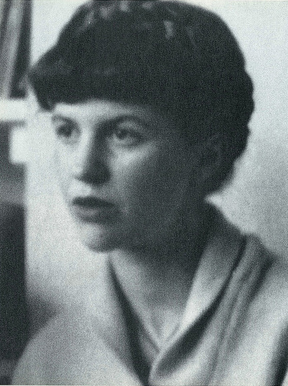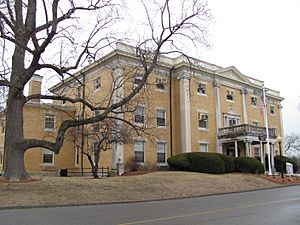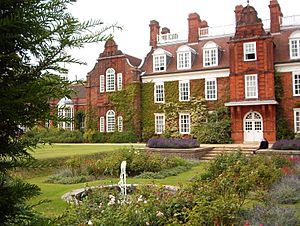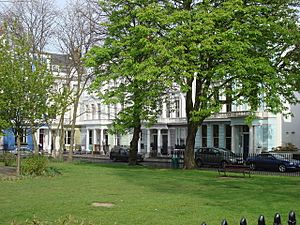Sylvia Plath facts for kids
Quick facts for kids
Sylvia Plath
|
|
|---|---|

Plath at her Chalcot Square flat in London, July 1961
|
|
| Born | October 27, 1932 Boston, Massachusetts, U.S. |
| Died | February 11, 1963 (aged 30) London, England |
| Resting place | Heptonstall Church, England |
| Pen name | Victoria Lucas |
| Occupation |
|
| Language | English |
| Alma mater | Smith College Cambridge University Boston University |
| Period | 1960–1963 |
| Genre |
|
| Literary movement | Confessional poetry |
| Notable works |
|
| Notable awards |
|
| Spouse | |
| Children |
|
| Relatives |
|
|
|
|
| Signature | |
Sylvia Plath ( October 27, 1932 – February 11, 1963) was an American poet, novelist, and short story writer. She is credited with advancing the genre of confessional poetry and is best known for two of her published collections, The Colossus and Other Poems (1960) and Ariel (1965), and also The Bell Jar, a semi-autobiographical novel published shortly before her death in 1963. The Collected Poems was published in 1981, which included previously unpublished works. For this collection Plath was awarded a Pulitzer Prize in Poetry in 1982, making her the fourth to receive this honour posthumously.
Born in Boston, Massachusetts, Plath graduated from Smith College in Massachusetts and the University of Cambridge, England, where she was a student at Newnham College. Plath later studied with Robert Lowell at Boston University, alongside poets Anne Sexton and George Starbuck. She married fellow poet Ted Hughes in 1956, and they lived together in the United States and then in England. Their relationship was tumultuous. They had two children before separating in 1962.
Plath was clinically depressed for most of her adult life, and was treated multiple times with early versions of electroconvulsive therapy (ECT).
Contents
Life and career
Early life
Sylvia Plath was born on October 27, 1932, in Boston, Massachusetts. Her mother, Aurelia Schober Plath (1906–1994), was a second-generation American of Austrian descent, and her father, Otto Plath (1885–1940), was from Grabow, Germany. Plath's father was an entomologist and a professor of biology at Boston University who wrote a book about bumblebees.
On April 27, 1935, Plath's brother Warren was born. In 1936 the family moved from 24 Prince Street in Jamaica Plain, Massachusetts, to 92 Johnson Avenue, Winthrop, Massachusetts. Plath's mother, Aurelia, with Plath's maternal grandparents, the Schobers, had lived since 1920 in a section of Winthrop called Point Shirley, a location mentioned in Plath's poetry. While living in Winthrop, eight-year-old Plath published her first poem in the Boston Herald's children's section. Over the next few years, Plath published multiple poems in regional magazines and newspapers. At age 11, Plath began keeping a journal. In addition to writing, she showed early promise as an artist, winning an award for her paintings from the Scholastic Art & Writing Awards in 1947. "Even in her youth, Plath was ambitiously driven to succeed."
Otto Plath died on November 5, 1940, a week and a half after Sylvia's eighth birthday, of complications following the amputation of a foot due to untreated diabetes. He had become ill shortly after a close friend died of lung cancer. Comparing the similarities between his friend's symptoms and his own, Otto became convinced that he, too, had lung cancer and did not seek treatment until his diabetes had progressed too far. Raised as a Unitarian, Plath experienced a loss of faith after her father's death and remained ambivalent about religion throughout her life. Her father was buried in Winthrop Cemetery in Massachusetts. A visit to her father's grave later prompted Plath to write the poem "Electra on Azalea Path".
After Otto's death, Aurelia moved her children and her parents to 26 Elmwood Road, Wellesley, Massachusetts, in 1942. Plath commented in "Ocean 1212-W", one of her final works, that her first nine years "sealed themselves off like a ship in a bottle—beautiful, inaccessible, obsolete, a fine, white flying myth". Plath attended Bradford Senior High School (now Wellesley High School) in Wellesley, graduating in 1950. Just after graduating from high school, she had her first national publication in the Christian Science Monitor.
College years and depression

In 1950, Plath attended Smith College, a private women's liberal arts college in Massachusetts. She excelled academically. While at Smith, she lived in Lawrence House, and a plaque can be found outside her old room. She edited The Smith Review. After her third year of college, Plath was awarded a coveted position as a guest editor at Mademoiselle magazine, during which she spent a month in New York City. The experience was not what she had hoped for, and many of the events that took place during that summer were later used as inspiration for her novel The Bell Jar.
She was furious at not being at a meeting the editor had arranged with Welsh poet Dylan Thomas — a writer whom she loved, said one of her boyfriends, "more than life itself". She hung around the White Horse Tavern and the Chelsea Hotel for two days, hoping to meet Thomas, but he was already on his way home. During this time she was not accepted into a Harvard writing seminar with author Frank O'Connor.
She spent six months in psychiatric care, receiving more electric and insulin shock treatment under the care of Ruth Beuscher. Her stay at McLean Hospital and her Smith Scholarship were paid for by Olive Higgins Prouty, who also recovered from a mental breakdown.
Plath seemed to make a good recovery and returned to college. In January 1955, she submitted her thesis The Magic Mirror: A Study of the Double in Two of Dostoyevsky's Novels, and in June graduated from Smith with an A.B., summa cum laude. She was a member of the Phi Beta Kappa academic honor society, and had an IQ of around 160.
She obtained a Fulbright Scholarship to study at Newnham College, one of the two women-only colleges of the University of Cambridge in England, where she continued actively writing poetry and publishing her work in the student newspaper Varsity. At Newnham, she studied with Dorothea Krook, whom she held in high regard. She spent her first year winter and spring holidays traveling around Europe.
Career and marriage

Plath met poet Ted Hughes on February 25, 1956. In a 1961 BBC interview (now held by the British Library Sound Archive), Plath describes how she met Hughes:
I'd read some of Ted's poems in this magazine and I was very impressed and I wanted to meet him. I went to this little celebration and that's actually where we met...Then we saw a great deal of each other. Ted came back to Cambridge and suddenly we found ourselves getting married a few months later...We kept writing poems to each other. Then it just grew out of that, I guess, a feeling that we both were writing so much and having such a fine time doing it, we decided that this should keep on.
Plath described Hughes as "a singer, story-teller, lion and world-wanderer" with "a voice like the thunder of God".
The couple married on June 16, 1956, at St George the Martyr, Holborn in London (now in the Borough of Camden) with Plath's mother in attendance, and spent their honeymoon in Paris and Benidorm. Plath returned to Newnham in October to begin her second year. During this time, they both became deeply interested in astrology and the supernatural, using ouija boards.
In June 1957, Plath and Hughes moved to the United States, and from September, Plath taught at Smith College, her alma mater. She found it difficult to both teach and have enough time and energy to write, and in the middle of 1958, the couple moved to Boston. Plath took a job as a receptionist in the psychiatric unit of Massachusetts General Hospital and, in the evening sat in on creative writing seminars given by poet Robert Lowell (also attended by the writers Anne Sexton and George Starbuck).
Both Lowell and Sexton encouraged Plath to write from her experience and she did so. Plath began to consider herself as a more serious, focused poet and short story writer. At this time Plath and Hughes first met the poet W.S. Merwin, who admired their work and was to remain a lifelong friend. Plath resumed psychoanalytic treatment in December, working with Ruth Beuscher.
Plath and Hughes traveled across Canada and the United States, staying at the Yaddo artist colony in Saratoga Springs, New York in late 1959. Plath says that it was here that she learned "to be true to my own weirdnesses", but she remained anxious about writing confessionally, from deeply personal and private material. The couple moved back to England in December 1959 and lived in London at 3 Chalcot Square, near the Primrose Hill area of Regent's Park, where an English Heritage plaque records Plath's residence. Their daughter Frieda was born on April 1, 1960, and in October, Plath published The Colossus, her first collection of poetry.
In February 1961, Plath's second pregnancy ended in miscarriage; several of her poems, including "Parliament Hill Fields", address this event. In a letter to her therapist, Plath wrote that Hughes beat her two days before the miscarriage. In August she finished her semi-autobiographical novel The Bell Jar and immediately after this, the family moved to Court Green in the small market town of North Tawton. Nicholas was born in January 1962. In mid-1962, Plath and Hughes began to keep bees, which would be the subject of many Plath poems.
In August 1961, the couple rented their flat at Chalcot Square to Assia (née Gutmann) Wevill and David Wevill. Hughes was immediately struck with the beautiful Assia, as she was with him. In June 1962, Plath had a car accident. In September 1962, Plath and Hughes separated.
Beginning in October 1962, Plath experienced a great burst of creativity and wrote most of the poems on which her reputation now rests, writing at least 26 of the poems of her posthumous collection Ariel during the final months of her life. In December 1962, she returned alone to London with their children, and rented, on a five-year lease, a flat at 23 Fitzroy Road—only a few streets from the Chalcot Square flat. William Butler Yeats once lived in the house, which bears an English Heritage blue plaque for the Irish poet. Plath was pleased by this fact and considered it a good omen.
The northern winter of 1962–1963 was one of the coldest in 100 years; the pipes froze, the children—now two years old and nine months—were often sick, and the house had no telephone. Her depression returned but she completed the rest of her poetry collection, which would be published after her death (1965 in the UK, 1966 in the US). Her only novel, The Bell Jar, was published in January 1963, under the pen name Victoria Lucas, and was met with critical indifference.
Death
Before her death, Plath tried several times to take her own life. She was found dead in her house of February 11, 1963. She was 30 years old.
Works
Plath wrote poetry from the age of 8, her first poem appearing in the Boston Traveller. By the time she arrived at Smith College, she had written over 50 short stories, and her work had been published in numerous magazines. At Smith, she majored in English literature and won all the major prizes in writing and scholarship, including literary prizes for her poetry. Additionally, she received a summer editor position at the young women's magazine Mademoiselle, and, on her graduation in 1955, she won the Glascock Prize for "Two Lovers and a Beachcomber by the Real Sea". Later, she wrote for the university publication Varsity.
Legacy
Some in the feminist movement saw Plath as speaking for their experience, as a "symbol of blighted female genius". Writer Honor Moore describes Ariel as marking the beginning of a movement, Plath suddenly visible as "a woman on paper", certain and audacious. Moore says: "When Sylvia Plath's Ariel was published in the United States in 1966, American women noticed. Not only women who ordinarily read poems, but housewives and mothers whose ambitions had awakened ... Here was a woman, superbly trained in her craft, whose final poems uncompromisingly charted female rage, ambivalence, and grief, in a voice with which many women identified." Some feminists threatened to kill Hughes in Plath's name.
Smith College, Plath's alma mater, holds her literary papers in the Smith College Library.
The United States Postal Service introduced a postage stamp featuring Plath in 2012. An English Heritage plaque records Plath's residence at 3 Chalcot Square, in London.
In 2018, The New York Times published an obituary for Plath as part of the Overlooked history project.
Publication list
Poetry collections
- The Colossus and Other Poems (1960, William Heinemann)
- Ariel (1965, Faber and Faber)
- Three Women: A Monologue for Three Voices (1968, Turret Books)
- Crossing the Water (1971, Faber and Faber)
- Winter Trees (1971, Faber and Faber)
- The Collected Poems (1981, Faber and Faber)
- Selected Poems (1985, Faber and Faber)
- Ariel: The Restored Edition (2004, Faber and Faber)
Collected prose and novels
- The Bell Jar, under the pseudonym "Victoria Lucas" (novel, 1963, Heinemann)
- Letters Home: Correspondence 1950–1963 (1975, Harper & Row, US; Faber and Faber, UK)
- Johnny Panic and the Bible of Dreams: Short Stories, Prose, and Diary Excerpts (1977, Faber and Faber)
- The Journals of Sylvia Plath (1982, Dial Press)
- The Magic Mirror (1989), Plath's Smith College senior thesis
- The Unabridged Journals of Sylvia Plath, edited by Karen V. Kukil (2000, Anchor Books)
I can never read all the books I want; I can never be all the people I want and live all the lives I want. I can never train myself in all the skills I want. And why do I want? I want to live and feel all the shades, tones and variations of mental and physical experience possible in my life.
- The Letters of Sylvia Plath, Volume 1, edited by Peter K. Steinberg and Karen V. Kukil (2017, Faber and Faber)
- The Letters of Sylvia Plath, Volume 2, edited by Peter K. Steinberg and Karen V. Kukil (2018, Faber and Faber)
- Mary Ventura and the Ninth Kingdom (2019, Faber and Faber)
Children's books
- The Bed Book, illustrated by Quentin Blake (1976, Faber and Faber)
- The It-Doesn't-Matter Suit (1996, Faber and Faber)
- Mrs. Cherry's Kitchen (2001, Faber and Faber)
- Collected Children's Stories (UK, 2001, Faber and Faber)
See also
 In Spanish: Sylvia Plath para niños
In Spanish: Sylvia Plath para niños



